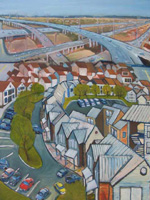
Suburban Sprawl | by Warren Goldie
Excerpt: The Ever-Evolving Encyclopedia, a 5th grade history text by the Galef Institute
Levitt bought a large amount of land outside New York City and began constructing houses a hundred at a time. Soon “Levittown” had more than 17,000 nearly identical homes. Before long, such housing developments were popping up on the outskirts of many other cities in areas that became known as suburbs.
Farmers soon discovered they could make a lot of money by selling their land to developers to make into suburbs. As a result, family farms began to disappear. Pastures and corn fields became housing developments, shopping centers and industrial parks.
There were some problems, however. Suburbs are more spread out than cities (where people can walk to shopping, for example), which meant that suburbanites had to drive most places. That meant more roads and cars — and more traffic jams and air pollution, too.
Suburban sprawl affects the environment in serious ways. For example, thousands of acres of wetlands have been drained and filled in to make room for new housing developments. Animals depend on those wetlands, and wetlands store rain water and help control flooding. The loss of wetlands hurts us all, as does the loss of forest land.
The need for new housing must be balanced with the need for open spaces. Fortuntely, today, more people are aware of these issues than ever before. Community groups in suburban housing developments hold regular meetings to discuss ways to best live together and solve their problems.
[Photo 8a: Levittown/Archive PhotosCaption: Young couples camped out in line for days for the chance to buy a home in Levittown.][Photo 8b: Species threatened by encroaching homes] Caption: [Map 8c: Eastern megalopolis] This is a population map of the East Coast. Between Boston and Washington, D.C., suburbs nearly connect one city to the next. What do you think this area looked like a hundred years ago? What do you think it will look like a hundred years from now?
Think About It:
Can we create more homes for people without building more suburbs? Is there any way we can make better homes from the ones we have rather than build new ones? [D: See if this is OK]
Be a Connective Detective!
Find the link between Suburban Sprawl and: THE MODEL T (Technology pack)
HENRY FORD (Technology pack)
Pull-Out Box:
Suburban sprawl is what happens when we build too many houses, roads and shopping centers without thinking much about how unattractive it will look. Some communities have avoided suburban sprawl by building lots of parks and planting trees in their neighborhoods.
